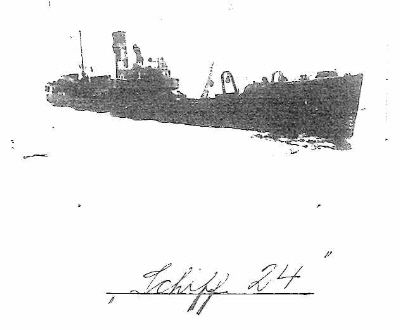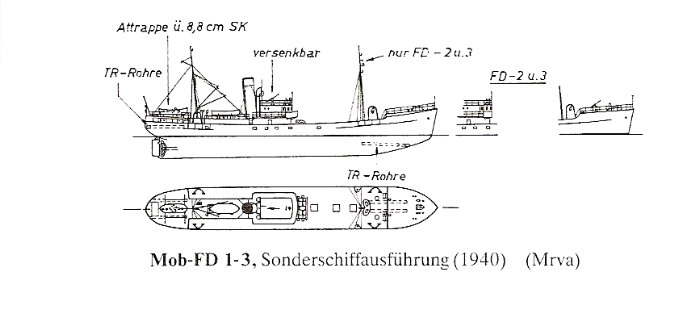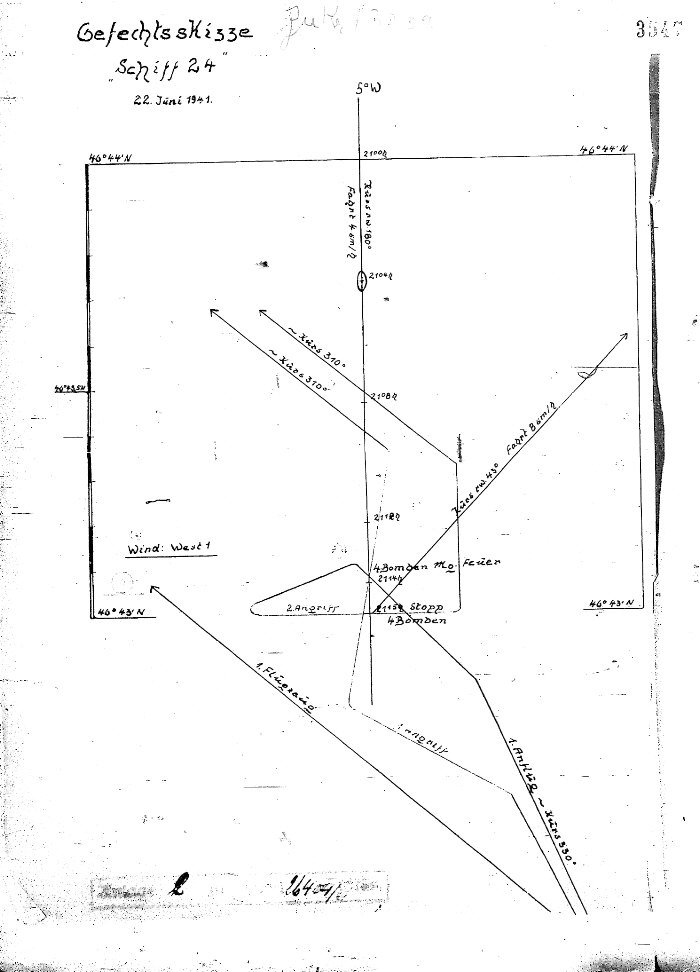HOME
Contact
Links
Sources
LogbookAIRCREW
Troup
Naylor
Herrick
Hewson
TACTICS
Training
Blenheim
Weapons
Formations
Tasks
MISSIONS
Scharnhorst
St Nazaire
Brest
Schiff 24
UJ 126
Condorcet
|
|

Kriegsmarine 'Shiff 24'
- Formerly Fishing Vessel 'Mars' or 'Saturn?'
Schiff 24 - The Ship With No Name
'Ship 24' . The ship with no name
- and yet several names. An armed decoy trawler that
masqueraded under many disguises, and many national
flags, following a historic tradition of naval deception
dating back hundreds of years. Perhaps the concept is
best known today as a 'Q' ship, such as the large
disguised merchantmen that were utilised to great effect
by the German Navy in the First World War.
But Schiff 24 belonged to a smaller class
of vessel, one whose role was to blend in with the local
fishing fleets and monitor coastal activity along the Bay
of Biscay. Operating alongside its sister ship, 'Schiff
13', it reported on the movements of ships and aircraft
in its area of operation, whilst also acting as a trap
for enemy submarines ('U-Bootfalle').
French, Portugese, and Spanish disguises
were carried, amongst others, to conceal not only its
identity but also the 8.8cm quick firing canon hidden
under a dummy lifeboat and the retractable 30cm machine
guns under concealed trapdoors, as well as the torpedo
tubes and anti-submarine equipment. In age-old naval
tradition, it was not illegal to sail under false colours
as a ruse - but in order to open fire or fight, a ship
was expected to display true identity (hence the 'raising
of the flag' scene, so common in wartime naval movies').

Although some evidence is contradictory,
it would appear that on 22 June 1941, Schif 24 was to
become the target of two Blenheim aircraft from 53 Sqn
based at RAF St Eval, in an encounter that left both
sides nursing their losses. The story today begins with
the brief entries in Charles' logbook: "Strike
on enemy M/V, 1000 tons, 4x250 G.P. 1 glanced off decks.
P/O Williams (A/C Y) turned before ETA. P/O Hewson (A/C
F) missing after leaving scene of attack."
Eric 'Nine-Lives' Hewson was a
close friend of Charles', who had initially trained with
him but had slipped back during the courses due to a
sequence of aircraft accidents that had earned him his
nickname. He had only recently joined 53 Squadron and
this was one of his first few operational sorties. The
day was to confirm his nickname in the most dramatic of
circumstances.
Another new squadron member P/O
Williams may have 'turned before ETA' for this
particular attack (did that annoy Charles? It is recorded
in other reports that Williams 'broke formation') but
records show that after turning away at 2051hrs Williams'
aircraft then dropped its bombs at 2128hrs in a more
northerly position on an ocean-going tramp steamer of
about 1500 tons in a convoy of 11 ships. Indeed, that
convoy would seem to have been the original target for
the mission; the tasking order asked for '6 aircraft of
53 Sqn and 1 of 217 Sqn to attack 14 motor vessels
reported at 1500 hrs. (AIR 25 459)
Tactics in Coastal Command had
changed since the high-level bombing attacks on the
Battle Cruisers and Naval Facilities during April: it had
been realised that the chances of hitting a ship from
high altitude were small. Consequently, low level
shipping sweeps over the Bay of Biscay were introduced,
with the aim of finding and destroying coastal shipping
on routes from Spain to the West Coast of France or
U-boats setting out on or returning from patrol in the
Atlantic. The advantage of this tactic was a hugely
increased chance of a bomb hitting the target as the
aircraft ran in directly towards it in a single vertical
plain: the disadvantage (for the same reason) was that of
becoming a straightforward target for anti-aircraft fire,
with little scope for evasive manoeuvering. PRO AIR
15/247 (Bombing Attacks by CC Aircraft on Enemy Surface
Craft - Record and Analysis) shows how the bomb hit rate
compared to height of release was analysed at the time,
in order to confirm the tactic. It would appear that only
attacks from less than 200' were ever succesful. Forty
years later, during the Falklands Conflict, the same
effect could be seen as Argentinian Skyhawks bravely and
succesfully used similar tactics with essentially similar
bombing equipment against Task Force shipping in
Falklands Sound. AIR 15/298 from July 1941 consolidates
the Coastal Command policy with instructions to attack
from the beam if the vessel is unarmed and from directly
ahead or astern if armed (in order to reduce the number
of defensive guns that could be brought to bear). The
aiming point for a beam attack should be the side of the
ship, and for an end-on attack the deck. It notes that
10% of hits would be 'glancing' and also helpfully
advises that the aircraft's forward guns should be used
to suppress flak during the attack.
The Coastal Command Narrative for
22 June 1941 (PRO AIR 24/379) adds detail to Charles'
logbook entry: "Aircraft B of 53 Squadron
dropped 4 x 250 lb General Purpose bombs on 1 motor
vessel at 2118 hrs from 50'. One bomb fell on deck and
bounced off without exploding. Two bombs overshot.
Fragments presumeably from a bomb hit aircraft which felt
explosion about 2 seconds after aircraft passed over
ship. Aircraft F is overdue from strike."
The 53 Sqn F540 records slightly more detail: "Direct
Hit on target observed but bomb failed to explode.
Fragments, presumeably from a bomb, hit aircraft in wing,
tailplane, and engine."
'Fragmentation damage' is a common
problem with low-level bombing attacks: after release a
slick bomb will continue to travel at much the same speed
as the releasing aircraft and will hit the target the
same time as the aircraft overflies it. In order to
prevent damage from one's own bomb fragments, a time
delay was set into the bomb fuse (often 11 seconds for CC
aircraft) so that the aircraft would be clear of the area
- but such fuses were not always reliable. An alternative
solution which was more common post war was to 'retard'
the bomb using plates which deployed into the airflow
after release, so that the bomb travelled more slowly
than the aircraft.
No further details of circumstance
leading up tothe attack could be found in the British
records, so to complete the story it now needed an
examination of Schiff 24's Kriegstagebuch (War Diary).
Fortunately, this had survived along with the majority of
German Naval records which were captured towards the end
of the war, and a desciption of the attack is here given
in the words of the ships's Captain Bludau (in my best,
but very poor, effort to translate from the German, for
which I apologise):
Bridge of “Schiff 24”
Lorient, 24 June 1941
To:
Western Naval Command Paris
Western Defence HQ Paris
3rd Coastal Defence Division Brest
Re: Combat Report on the bombing attack which happened on
the 22 June.
Ship’s position at 2100 hrs: Lat = 46° 44’ N
Long = 05° 00’ W
Wind: Westerly Force 1, Seastate: 0-1, Weather: scattered
cloud
Visibility: 18km, with the Sun in the West.
2105 hrs. The topdeck lookout reported “Aircraft off
the port bow”. The aircraft was an English machine
like a Lockheed Hudson, which was flying at about 400m
high on a course of roughly 310 degrees, 2000 meters
(estimated) past us in front. As was usual on the
appearance of a hostile aircraft the hatches were closed
and access onto the maindeck was forbidden. Two marines
acted as lookouts whilst working on the fishing nets.
2110 hrs While that aircraft was passing behind us to
starboard, another 2 aircraft were sighted flying side by
side ahead of us at a height of 50 to 60 meters. They
were of a similar type, and were flying towards the ship.
At that stage of the alert nothing was changed from what
I had decided on the 11 June with regard to provoking
low-flying aircraft. (See Ship’s Diary pages 36/37).
At a distance of about 1,000 meters the right hand
aircraft turned to port. I assumed that it would fly past
in front of us like the first one.
2114 hrs The third aircraft flew past close behind the
stern.
2115 hrs After the second aircraft that was apparently
flying on past in front of us had crossed our bows at
about 800 meters ahead, it turned to starboard and flew
towards the ship from a few degrees off the starboard bow
at low level. Since this kind of occurrence had already
happened on previous occasions, I maintained my original
course and speed, specifically to emphasise that my
Spanish disguise was genuine. About 50 meters in front of
the ship four Bombs were released, estimated at between
50 and 100kg in size. The bombs on these aircraft were
not hung externally but were carried in an internal
bomb-bay under the fuselage with 6 to 8 racks (like a
Sunderland or a Bristol Blenheim). One of these bombs
ripped through the aft mast at the height of the derrick
and exploded there. The other three landed 20 meters
behind the ship. On this occasion two explosions were
observed, at the impact and about 5 to 8 seconds
afterwards. It is probable that perhaps two bombs had
impact fuses and the other two had a time delay fuse in
order to be effective against submarines. Putting the
rudder hard to port and an increase in speed had no real
effect because of the short time between release and
impact (3-4 seconds) and the late stage at which the
order was given. On seeing the bombs being released I
ordered the air raid warning alarm but because of a
failure in the alarm system there was a delay before it
went out. As a result of that, the second electric motor
which is needed to operate the lifting mechanism for the
C/30 machine guns was not engaged straight away. Then,
because communication could not be established with the
engine room either by telephone or voicepipe and the
revolution counter indicated ‘stopped’, I
assumed that the attack had caused considerable damage to
the engine or to the personel on duty, so I ordered the
C/30 Machine guns to be deployed by hand and I sent a
runner to the engine room to report on the cause of the
engine failure.
2117 hrs Meanwhile, the aircraft that had flown past the
stern now made a low-level attack from the starboard
beam. Four equally spaced bombs missed their target and
exploded in the way that has previously been described,
about 50 meters beyond the port beam. No further attack
was made. Both aircraft flew off on a course of
approximately 310 degrees and were very quickly out of
sight. One aircraft got rid of its remaining bombs by
jettisoning them in the sea about 1,500 meters away,
without any target.
After the second attack the Engineer on Watch, Ob. Gfr.
Somerfeld (who was injured) came on to the upperdeck and
reported to me that he had stopped the engine since the
steam turbine had no oil as a result of damage to the
turbine oil pressure tank. In addition, a small fire had
broken out and filled the room with smoke but he had
checked that it had not spread. Straight after the first
attack Masch Mt Lehmann had hurried into the engineroom,
extinguished the fire and established that the engine was
capable of giving 9 knots. Since we could no longer
complete our mission, I took the decision to head
straight for Lorient. Clearing up the damage and work on
the camouflage began at once. And so, in the guise of a
normal Patrol Boat, I arrived in Lorient at 0730 on the
23rd June.
The conduct of the crew was exemplarary throughout.
DAMAGE
To Personnel: L.M. Obermaschinist d.R. Winzenburger, who
was positioned beneath the aft superstructure, died 1 ½
hours later.
Aft Lookout: Matr. Gfr. Krings, was killed instantly.
On watch in the Engine room: Masch. Gfr. Günter died ¼
hour later.
To Equipment:
As a result of the loss of the turbine the engine was
only good for up to 9 knots, and even that for a limited
time only.
The ship’s radio suffered from interference and poor
transmission for ½ an hour, since the aerial had been
completely destroyed.
The electrical system for firing the torpedoes was out of
action, and the air pipes for the aft tubes were split in
very many places.
The bearings for the 88mm gun were destroyed.
Two standby aerials were rigged up (3.5 meters for
transmission, 1.5 meters for reception) and 3 signals
were sent (see annexes 2-4). The battle damage report was
not acknowleged. I sent the other two signals in the hope
that Long Wave would not be swamped by static but
reception of any kind was unreliable - that’s why
signals number 19 and 20 were not received clearly. So I
sent a new request by Short Signal which is shown as
number 21 giving my intention to put in to Lorient, and
this was retransmitted satisfactorily.
As a result of this incident I asked (also by signal) for
a suitable berth to be made ready at Lorient if possible.
In addition, it was necessary to ask for medical help
(either a Ship’s Medic or a Doctor).
COMMENTS
I have two possible explanations for this attack:
1.) That, on 11 June, the English pilot took photographs
and our disguise was recognised. Under high quality
enlargement the fake was revealed, and the reason could
only be a Q-ship.
2.) On the same basis, the attacks on French fishing
boats can be explained: because of the lack of success in
hunting U-boats in the Bay of Biscay, the English suspect
that fishing boats are helping protect the submarines,
and want to destroy those that are fishing in the areas
which are declared to be inside the German blockade.
I suspect that the second case is the more probable. This
is suggested by the fact that if the ship had been chosen
as a specific target for bombing there would most likely
have been many more air attacks several days earlier in
order to guarantee success.
As a result of this attack a Q-ship was partially
destroyed and the existence of its guns was revealed.
Furthermore it must be noted that the crew would have
been spotted coming out of their quarters to get the
Anti-aircraft guns ready for action inbetween the first
and second attack, and so any continued deception by
having covers over the fish hatches has become useless.
Whether any of these points is true will become apparent
as a result of the future behaviour of English pilots
towards Schiff 13.
The attack shows once again the element of luck that
hangs over ships under such circumstances. There is no
way of telling whether the arrival of the aircraft was
intentional or merely happened by chance, so this raises
two questions, which must be clarified unequivocably:
1.) Should low flying aircraft be shot at ? (There is
about 40 seconds warning) The risk here is that because
of the lack of certainty of shooting down one aircraft,
let alone several, it would thereby further jeopardise
the current task and compromise the disguise for future
missions.
2.) After one low level attack should the camouflage be
maintained during future attacks?
Such questions are for a higher authority to consider,
but must be thoroughly discussed for application in sea
areas which are frequently patrolled by the enemy air
force.
This encounter with English pilots helps make it clear
that, whilst the second scenario did not happen in my own
case, the disguise should only be shed in the most
extreme circumstances and that is made obvious in the
enclosed War Diary.
So in summary the most likely sequence of events is
that the first aircraft to fly on past Schiff 24 is P/O
Williams who has turned North earlier than the other 2
Blenheims and does not attack. Five Minutes later
Charles' Blenheim jinks left then right to makes a
first-pass head-on attack from the South, with one bomb
exploding above deck level as it hit the aft mast
(possible interpreted as having 'bounced off the deck')
and thus showering the Blenheim with fragments.
Meanwhile, Eric Hewson flies past the stern of the ship -
perhaps to identify it, or perhaps because he was not
well placed to release his bombs - and then turns through
a wide circle to re-attack from the West. By that time,
well stirred up by Charles' bombs and forewarned by
Eric's manoeuvering, the ship's guns are now unstowed and
Eric is hit during his pass. Both Blenheims are seen to
fly out of sight to the Northwest, with Schiff 24 unaware
that they have dealt Eric's aircraft a fatal blow (and
hence why he is seen to jettison objects). Eric's own
account of the action reveals that they flew on for a
further 15 minutes before the aircraft broke in half and
crashed into the sea form a heigh of 10'. Link to the
'Hewson' page for a more detsailed account of his
adventure.

Note: All Coastal Command records give
ship's position as Grid DPCT 5254 = 4652N 0506W (which is
very close to Schiff 24's own record). One can probably
assume the Ship's log was more exact than that recorded
by the aircraft, which may have been taken a few minutes
after the attack.
TOP
|